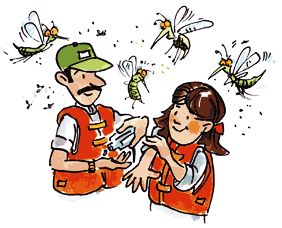Deet, Picaridin and Eucalyptus Oil
In this article we are going to discuss our personal experiences with insect repellents and what, in our opinion, works best and will give you the most bang for your buck. In general, the insect repellent market has become over-saturated with “name” brand products and many different styles to choose from. Nowadays when you go into a store you are presented with so many different options it is hard to know which to buy. All of this really comes down to some very simple factors and if you follow this guide you will be sure to have the right repellent when the bugs get bad.
The two major types of active ingredient in most insect repellents are Picaridin and Deet. Deet has been around for some time and is the most commonly found ingredient while Picaridin is relatively new. Reports have shown that both are almost equally effective at repelling bugs however most of that depends on the concentration of the product.
The concentration of Deet or Picaridin essentially dictates how long the product will be effective for. The higher the concentration, the longer the bug repellent will last. So when looking at the ingredients of the bug repellent most people will look for the highest concentration of the active ingredient.
Deet was created by the US Army in 1946 and has since then been adapted as the most commonly used bug repellent available. It can be found in almost all brands of repellent from Off to Cutter and its effectiveness varies by its concentration. Some of the downsides of Deet are its awful smell and harsh properties. If you get Deet on plastic or polyester based products, such as sunglasses, it can be corrosive and damaging. You also want to avoid getting Deet in the eyes or mouth as it can sting and taste very bad.
Picaridin is an alternative to Deet with a much shorter history. Introduced first in Europe around 2001 and then later in the US in 2006, Picaridin has grown in popularity as an alternative to Deet that lacks the harsh odor and corrosive properties often found in Deet products. Studies have shown the Picaridin can be as effective as Deet and in some cases even more effective. While it is a relatively new player in the market, Picaridin is certainly something you may want to check out if you have an allergy to Deet or just want to try a different product.
For those of you looking for a more natural approach to insect repellent, meet your new friend Eucalyptus Oil. If you have ever seen a Eucalyptus tree or smelled it’s leaves then you know it carries a strong, but not necessarily unpleasant, odor. The oil of the Eucalyptus tree has been used as a natural bio-pesticide for years to help keep insects at bay and also works on humans as a natural insect repellent. Just make sure you don’t mind the small of the Eucalyptus tree before using it.
Wipes, Pump Spray, Aerosol or Lotion?
Great, so you now know the difference in active ingredients in insect repellent. Next you need to know the best application format to buy. It is our opinion that you are best off buying a lotion based or direct application (straight out of the bottle) product. In other words, avoid the pumps, sprays, aerosols or wipes. These products, especially the aerosol, are designed to get you to waste half the bottle so you have to buy more sooner. If you must go with a spray applicator stay away from the aerosol products and go for the manual pump based solutions. You will get much more for your money this way and you can easily control the application so not to over-do it. The best bet, of course, is to purchase a lotion or direct application product. This allows you to control exactly how much product you use and waste as little as possible.
Active Ingredient Amount
When shopping for insect repellent we suggest looking for the highest concentration of the active ingredient available. The active ingredient is almost always displayed right on the front of the product and will be a percentage-based number that is hard to miss. If you are buying Deet the active ingredient is often times as high as 99%. Some studies suggest that an active ingredient of over 60% really doesn’t make much of a difference so as long as you are above that threshold you should be good. With Deet, an active ingredient of over 60% should protect you for at least 6 hours.
Picaridin’s active ingredient typically only comes in concentrations of no more than 20%. This doesn’t mean it is less effective than Deet, it just requires less of the chemical for it to work. A Picaridin product with a 20% concentration should also last at least 6 hours.
Eucalyptus Oil based repellent products typically come in a solution where at least 40% of the product consists of the active oil ingredient however given its natural properties you can most likely find some products with higher concentrations of the oil. A solution of 40% Eucalyptus oil should last you up to 6 hours.
What to Buy
So, what is the best kind of insect repellent to buy? It depends on your preference of active ingredient. Here are our recommendations of the best insect repellent brands to consider.
Deet
Repel 100 is a solid product that has a high concentration of deet and a manual pump spray applicator to help control how much you use. Click here for more information on Repel 100 products.
Eucalyptus Oil
Repel offers a Eucalyptus Oil based product for insect repellent as a natural alternative to Deet or Picaridin. This product contains 40% active ingredient.











Responses